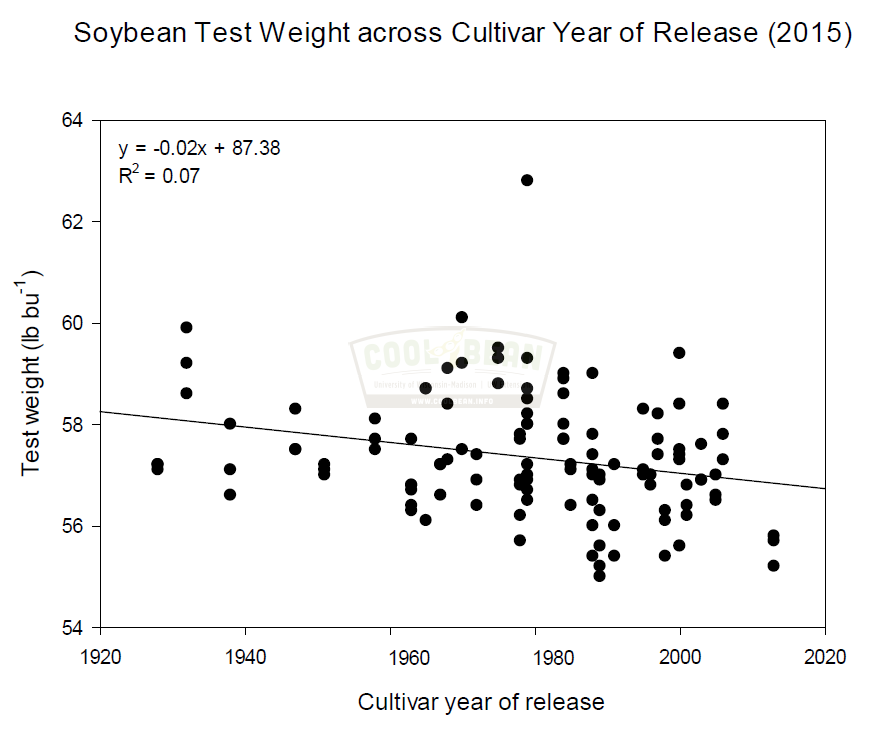I recently posted a blog, “
Test Weight Matters in 2019”, that test weight was trending down this fall. It did really matter, but no one really seemed to care unless it dropped below 54 pounds. In the article I stated: “However, this (past) fall grain quality was an exception to the norm of No. 1 yellow soybeans resulting in empty pods, shrunken seed (low test weight), discolored and generally poor-quality beans.” The wet fall weather and delayed harvest were the culprits.
Remember that buyers use 60 lb. test weight for soybeans to calculate bushels from delivery weight. Test weight is usually a few lbs. lower though. If you track your scale tickets at delivery you are probably seeing numbers in the 56 to 58 lb. range, enough to meet Grade 1 specifications. The official minimum soybean test weight grade requirements are as follow: Grade 1: 56.0 lbs., Grade 2: 54.0 lbs., Grade 3: 52.0 lbs. and Grade 4: 49.0 lbs. This information can be found at
Quality Standards for U.S. Soybeans and Soy Products.Test weight is both a function of density per seed and density per volume. Large round seeds pack fewer seeds per volume than smaller seeds. And density per seed is the amount of oil and protein packed in the individual seed with protein being more compact than oil. Density per seed and density per volume (such as a bushel) does matter.
The original question is whether test weight is trending down in soybeans. Shawn Conley, soybean specialist at the University of Wisconsin, provided this graph and comment: “Here is a little data that shows that “possibly” the chase for yield may also be deleterious to test weight.” However, while the trend is downward, there is quite a bit of variation around the trendline.
A soybean breeder read my blog and wrote: “I read your article on test weight in soybean and had a couple questions. It mentions low test weight being an indicator of late season stress. I am also curious on your thoughts whether these items would affect test weight.”
Now we have a lot more conjecture than actual answers. However, a team is trying to answer some of these basic questions through a project titled “Value of Soybean Constituents,” funded by the soybean checkoff. The focus is to understand if changes in physical attributes such as seed size or test weight have impacted the underlying value of soybeans.
1. “High yields with lots of seed set – Is low test weight an indication that we had more seeds to fill than what the plant could remobilize nutrients to fill completely? Many times (with) “stress” we think of low yields, but in this case, yields may be driven by high seed number, but we don’t have the plant health/nutrient loading ability to fill all of them, thus causing stress.”
Dr Emerson Nafziger, emeritus crop scientist at the University of Illinois, said “I suppose it’s plausible, but if that’s the case then weight per seed should be declining, along with seed density (weight divided by volume of individual seeds). I don’t think seed weight has been declining, but not sure how much density (ever) gets measured. Lower density could result from how dense the cotyledons are, or how thick and dense the seed coat is, or both.”
“The main issue is whether this means any lower yield of protein or oil per pound of seed. If not, then it would seem to be mostly a cosmetic change, although I know the extraction (crush) plants talk about higher volume limiting capacity. It would seem to be a small thing to increase dehulling capacity, if after dehulling everything runs the same.”
2. “Large seed vs. small seed – Is it possible that the size of the seed affects how much of the volume of the 1-quart container is occupied by actual seed and how much is filled with air between seeds? Thus, large seed size may drive test weight down, due to more space being consumed by air?”
Test weight is both a function of density per seed and density per volume. Large round seeds pack fewer seeds per volume than smaller seeds.
3. “As we plant soybeans earlier, are we reaching maturity soon enough in September that warmer temperatures cause faster dry-down and we lose test weight faster?”
Natural dry-down, as a natural isolated event, will increase test weight as moisture has a density of 1 and as it goes away (seed dries down), we are left with components (carbohydrates, oil and protein) that have densities greater than 1.
Ignacio Ciampitti, soybean specialist at Kansas State University said, “In my experience, test weight is not connected with planting or harvesting date, but what are the environmental conditions affecting the soybean plants during the seed filling—interrupting the duration (or rate) of this process.”
4. “Does protein and oil content influence test weight?”
Test weight is a function of density per seed and density per volume. And density per seed is the amount of oil and protein (and remnant carbohydrate) packed within individual seeds with protein being more compact than oil. Seed can be densely or loosely packed, like starch in corn seed. Chris Schroeder with Centrec Consulting in Savoy, Ill., has been studying test weight trends and says: “There are no strong linear correlations found between test weight and oil level, test weight and protein level based on four datasets. Oil level and test weight show weak negative correlations. No clear correlations are found between test weight and protein level.”
So, we have a lot of questions about test weight, its trend and its impact. But the question remains, does it matter if we maintain desired market grade?
Soybean agronomist Dr. Daniel Davidson posts blogs on topics related to soybean agronomy. Feel free to contact him at djdavidson@agwrite.com or ring him at 402-649-5919.


